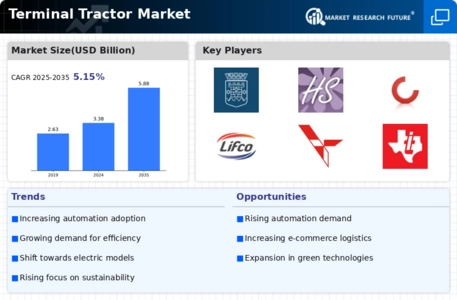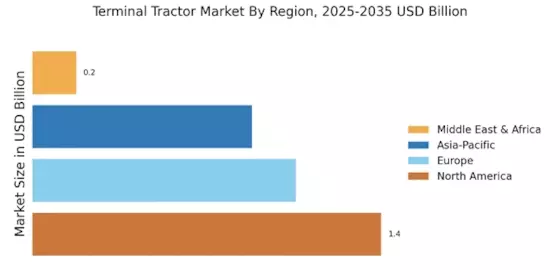Rising E-commerce Activities
The Terminal Tractor Market is significantly influenced by the rise in e-commerce activities. As online shopping continues to gain traction, the demand for efficient goods handling and transportation solutions is escalating. E-commerce giants are investing heavily in their logistics infrastructure to meet consumer expectations for rapid delivery. This trend is reflected in the increasing number of fulfillment centers and distribution hubs, which require terminal tractors for effective internal logistics. Market data indicates that e-commerce sales are expected to reach over 6 trillion dollars by 2024, further intensifying the need for terminal tractors. Consequently, the growth of e-commerce is likely to be a key driver for the terminal tractor market, as companies seek to streamline their operations and enhance delivery capabilities.
Focus on Automation and Smart Technologies
The Terminal Tractor Market is witnessing a notable shift towards automation and smart technologies. As industries strive for greater efficiency, the integration of automated terminal tractors is becoming more prevalent. These advanced machines are equipped with features such as GPS tracking, telematics, and autonomous driving capabilities, which enhance operational efficiency and safety. The market for automated logistics solutions is projected to grow significantly, with estimates suggesting a CAGR of 10% over the next five years. This trend indicates that companies are increasingly prioritizing automation to reduce labor costs and improve productivity. The adoption of smart technologies in terminal tractors is likely to reshape the market landscape, driving innovation and competitiveness.
Expansion of Port and Terminal Infrastructure
The Terminal Tractor Market is benefiting from the expansion of port and terminal infrastructure. As global trade continues to grow, investments in port facilities and logistics hubs are increasing. This expansion necessitates the use of terminal tractors for efficient cargo handling and transportation within these facilities. Recent data indicates that port infrastructure investments are projected to exceed 100 billion dollars over the next decade. This growth is likely to create a favorable environment for terminal tractor manufacturers, as the demand for efficient cargo movement rises. The expansion of infrastructure is expected to drive the adoption of terminal tractors, as companies seek to enhance their operational capabilities and meet the demands of increasing trade volumes.
Environmental Regulations and Sustainability Goals
The Terminal Tractor Market is being shaped by stringent environmental regulations and sustainability goals. Governments worldwide are implementing policies aimed at reducing carbon emissions and promoting cleaner technologies. As a result, terminal tractor manufacturers are focusing on developing electric and hybrid models to comply with these regulations. The market for electric terminal tractors is expected to grow at a CAGR of 15% over the next five years, driven by the increasing emphasis on sustainability. Companies are recognizing the importance of aligning their operations with environmental standards, which is likely to boost the demand for eco-friendly terminal tractors. This shift towards sustainability is not only beneficial for the environment but also enhances the reputation of companies within the industry.
Increased Demand for Efficient Logistics Solutions
The Terminal Tractor Market is experiencing a surge in demand for efficient logistics solutions. As supply chains become increasingly complex, companies are seeking ways to optimize their operations. Terminal tractors, known for their maneuverability and efficiency in transporting goods within ports and warehouses, are becoming essential. According to recent data, the logistics sector is projected to grow at a compound annual growth rate of 4.5% over the next five years. This growth is likely to drive the adoption of terminal tractors, as businesses aim to enhance their operational efficiency and reduce turnaround times. The need for faster and more reliable logistics solutions is pushing companies to invest in advanced terminal tractor technologies, thereby propelling the market forward.


















Leave a Comment